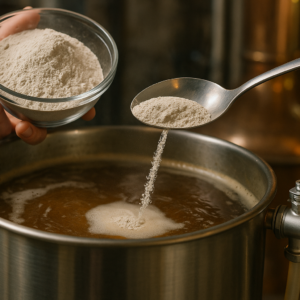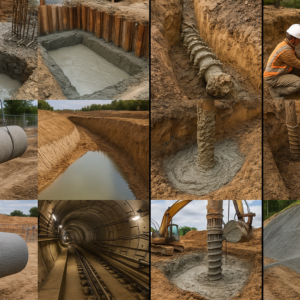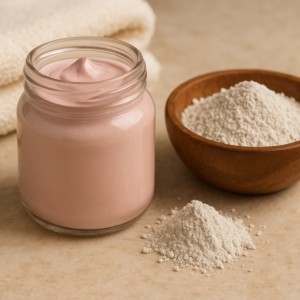Iron ore pelletization stands as one of the steel industry’s most critical processes. At its heart lies a simple but powerful material: bentonite clay. This natural binder transforms fine iron ore particles into durable pellets that can withstand the intense heat of blast furnaces. But not all bentonite is created equal. Different types serve different purposes in pellet plants, each bringing unique properties that affect pellet quality, production efficiency, and final iron content.
Understanding these variations matters for anyone involved in steel production, from plant managers optimizing their processes to suppliers selecting the right materials. Let’s break down the main types of bentonite for iron ore pellet applications and what makes each one suitable for specific needs.
What Makes Bentonite Essential for Iron Ore Pelletization
Before diving into types, it helps to understand why bentonite works so well as a pellet binder. Bentonite is composed primarily of montmorillonite, a clay mineral with a unique layered structure. When mixed with water and iron ore concentrate, bentonite swells and creates a gel-like matrix that holds fine ore particles together.
The pelletization process transforms iron ore fines (particles typically less than 45 micrometers) into spherical pellets measuring 6 to 16 millimeters in diameter. These pellets must be strong enough to survive handling, transportation, and the demanding conditions inside a blast furnace. Bentonite provides both green strength (the strength of wet pellets before firing) and helps develop fired strength after heat treatment.
Pellet plants typically add bentonite at rates between 0.5% and 1.5% by weight of the iron ore concentrate. While this seems minimal, the choice of bentonite type directly impacts pellet quality, production costs, and the final iron grade of the pellets.
Sodium Bentonite: The Industry Standard
Sodium bentonite dominates iron ore pelletization worldwide. This natural clay, where sodium ions occupy the interlayer spaces in the montmorillonite structure, offers the highest swelling capacity among bentonite types.
Why Sodium Bentonite Excels
When sodium bentonite absorbs water, it can expand 15 to 20 times its dry volume. This dramatic swelling creates a fibrous network throughout the pellet, binding ore particles tightly together. The expanded clay particles fill voids between ore grains and create numerous contact points, generating strong capillary forces that hold the pellet structure intact.
Plant operators favor sodium bentonite because it delivers:
Superior green pellet strength. Wet pellets can withstand the mechanical stress of moving through disc or drum pelletizers and transportation systems without breaking apart.
Better drop resistance. Green pellets maintain integrity when dropped from typical handling heights, reducing dust formation and material loss.
Consistent performance across ore types. Sodium bentonite works effectively with various iron ore concentrates, from magnetite to hematite.
Lower dosage requirements. Thanks to its high swelling capacity, plants can achieve target pellet properties with less bentonite compared to other types, preserving the iron content of the final pellets.
The Kutch region of India produces particularly high-quality sodium bentonite with natural advantages. These deposits contain higher iron content (up to 15% in some grades), which means adding bentonite doesn’t dilute the pellet’s iron grade as much as lower-iron varieties. CMS Industries sources bentonite from mines in the Kutch region, including locations in Mandvi, Vandh, and surrounding areas, where volcanic ash weathered under specific conditions millions of years ago created exceptionally pure sodium bentonite deposits.
Technical Specifications for Pelletization
High-quality sodium bentonite for pelletization typically contains at least 70% montmorillonite, though premium grades may reach 85% to 90%. Other key specifications include:
- Swelling index: 25 to 30 times dry volume
- Methylene blue absorption: Higher values indicate better binding capacity
- Moisture content: Usually controlled to below 12%
- Particle size: At least 80% passing through a 325-mesh sieve (45 microns)
These properties ensure the bentonite disperses evenly throughout the filter cake and develops strong bonds between ore particles.
Discover which bentonite products are trending in 2025 for skincare and why beauty experts can’t stop talking about their natural detox power.
Calcium Bentonite: The Cost-Effective Alternative
Calcium bentonite, where calcium ions occupy the interlayer positions rather than sodium, represents another option for pellet plants. This type swells less dramatically than sodium bentonite (typically only 2 to 3 times its dry volume) but offers certain advantages.
When Calcium Bentonite Makes Sense
Raw calcium bentonite finds limited direct use in pelletization because its lower swelling capacity means plants need higher addition rates to achieve comparable pellet strength. At 0.5% to 1.5% dosage levels, pure calcium bentonite often can’t provide adequate green strength.
The economic appeal comes from its wider availability and lower cost in certain regions. Some operations use calcium bentonite where pellet strength requirements are less stringent or where local deposits make it the most accessible option.
Performance Characteristics
Calcium bentonite forms denser lees compared to sodium bentonite’s fluffier structure. The stronger interlayer bonding from divalent calcium ions creates more stable but less expansive structures. For pelletization, this translates to:
- Lower water absorption capacity
- Reduced dispersion in the ore matrix
- Higher dosage requirements for equivalent strength
- Different moisture distribution patterns in green pellets
These characteristics make pure calcium bentonite less ideal for most modern pellet operations focused on maximizing efficiency and iron grades.
Sodium-Activated (Modified) Calcium Bentonite
Here’s where chemistry improves performance. Through a process called sodium activation, producers can enhance calcium bentonite’s binding properties by treating it with sodium compounds like sodium carbonate.
The Activation Process
Sodium activation involves adding 5% to 10% of a soluble sodium salt to wet calcium bentonite. After thorough mixing, ion exchange occurs where sodium ions replace some calcium ions in the interlayer spaces. The result is a modified bentonite with improved swelling characteristics.
This process bridges the gap between pure calcium and pure sodium bentonite. Sodium-activated calcium bentonite swells more than untreated calcium bentonite (around 5 to 6 times dry volume) while costing less than natural sodium bentonite.
Application in Pellet Plants
Many operations use sodium-activated calcium bentonite as a balanced solution. CMS Industries offers both natural sodium bentonite and calcium bentonite grades that can be customized for specific pelletization requirements, helping plants optimize the balance between performance and cost.
The activated form works particularly well when:
- Natural sodium bentonite costs are prohibitively high
- Local calcium bentonite deposits are readily available
- Moderate swelling capacity meets pellet strength requirements
- Plants can accept slightly higher addition rates
One limitation: activated bentonite may not fully replicate every property of natural sodium bentonite. Some characteristics like viscosity and fluid loss might differ slightly. Plants switching from natural sodium to activated calcium bentonite should conduct trials to verify performance meets their specific needs.
Specialty High-Iron Bentonite Grades
Recent developments have produced specialized bentonite grades designed specifically for pelletization. These premium products address one of bentonite’s main drawbacks: the addition of silica and alumina impurities that dilute the pellet’s iron content.
Iron-Enriched Formulations
Some manufacturers, including CMS Industries, offer iron ore pelletization bentonite with elevated natural iron content. These grades can contain 12% to 15% iron oxide, compared to 3% to 6% in standard bentonites.
The advantage becomes clear in the math. If a pellet plant adds 1% bentonite to achieve target green strength, high-iron bentonite contributes more iron to the final pellet chemistry. This helps maintain higher total iron grades in the finished pellets, improving their value for steelmaking.
Montmorillonite Content and Purity
Premium pelletization grades push montmorillonite content toward 85% to 90%, sometimes reaching 95% in the purest varieties. Higher montmorillonite content means:
- More effective swelling per unit of bentonite added
- Better dispersion throughout the ore matrix
- Stronger binding at lower dosage rates
- Less non-clay impurities in the pellets
These high-purity grades allow plants to reduce bentonite addition rates by 20% to 30% compared to standard grades while maintaining pellet quality. The reduced dosage directly improves pellet iron content and reduces the formation of slag during blast furnace operations.
Bentonite-Polymer Composite Binders
The newest development in pelletization binders combines bentonite with organic polymers to create hybrid systems that outperform bentonite alone.
How Composite Binders Work
These systems typically use reduced bentonite (around 1.0% instead of 2.0%) combined with small amounts (0.01% to 0.05%) of polymer additives. The polymers may be cellulose-based or polyacrylamide derivatives.
The combination provides benefits from both components:
- Bentonite supplies thermal stability and fired pellet strength
- Organic polymers enhance green and dry pellet strength
- Polymers burn off during firing, leaving no residue
- The porous structure after polymer decomposition improves oxygen diffusion during roasting
Research shows these composite binders can produce pellets with compressive strength exceeding 550 Newtons per pellet while using half the bentonite of conventional formulations. This means significantly higher iron grades in the finished pellets.
Adoption Challenges
Despite promising results, composite binders haven’t replaced traditional bentonite at most operations. Reasons include:
- Higher cost per ton of binder system
- Need for separate handling and mixing equipment
- Unfamiliarity with organic binder chemistry
- Conservative procurement practices in established plants
As the technology matures and more plants document successful implementations, adoption will likely increase, particularly at operations where maximizing pellet iron content justifies the added complexity.
Selecting the Right Bentonite Type for Your Operation
Choosing between bentonite types depends on multiple factors specific to each pellet plant. Here are the key considerations:
- Ore characteristics matter. Fine ore concentrates with high specific surface area need more binder. Coarser ores may achieve adequate strength with lower bentonite rates. The iron ore mineralogy (magnetite versus hematite) and particle size distribution affect how bentonite disperses and bonds.
- Target pellet properties drive decisions. Pellets destined for blast furnaces need high cold compression strength (typically above 250 kg per pellet) and thermal shock resistance. Direct reduction pellets may have different strength profiles. Match the bentonite type to your quality specifications.
- Iron grade requirements set limits. Steel mills increasingly demand higher iron content pellets. Each percentage point of iron matters. High-purity, high-iron bentonite grades justify their premium cost when iron content is the priority.
- Cost structure affects choices. Beyond the raw bentonite price, consider transportation costs, storage requirements, and handling systems. A plant near natural sodium bentonite deposits might choose differently than one importing bentonite from distant sources.
- Process conditions influence performance. Disc pelletizers versus drum pelletizers create different mechanical stresses. Moisture levels, mixing times, and induration temperatures all affect which bentonite type performs best.
Quality Control and Testing Protocols
Consistent bentonite quality ensures consistent pellet quality. Reputable suppliers like CMS Industries maintain rigorous testing programs to verify each shipment meets specifications.
Standard Test Methods
Pellet plants should verify these properties for incoming bentonite:
- Montmorillonite content: Determined through methylene blue absorption tests or X-ray diffraction analysis. Higher values indicate better binding potential.
- Swelling index: Measured by observing volume expansion in water over 24 hours. Sodium bentonite should achieve 25 to 30 times expansion.
- Moisture content: Typically kept below 12% to prevent clumping and ensure accurate dosing.
- Particle size distribution: Measured through wet sieve analysis. Proper grinding ensures bentonite disperses evenly in the ore matrix.
- Chemical composition: Analysis for SiO2, Al2O3, Fe2O3, CaO, MgO, and alkali content helps predict pellet chemistry.
Regular testing catches variations before they affect pellet quality. Plants should maintain relationships with suppliers who provide certificates of analysis and support troubleshooting when performance issues arise.
The Future of Bentonite in Pelletization
The pelletization industry continues evolving toward higher efficiency and lower environmental impact. Several trends will shape bentonite use going forward:
Bentonite reduction research. Extensive work focuses on minimizing bentonite addition rates through improved ore preparation, better mixing systems, and enhanced binder formulations. Even small reductions translate to significant iron grade improvements across millions of tons of pellet production.
Hybrid binder systems. Expect more plants to trial bentonite-organic combinations as polymer costs decrease and performance data accumulates. These systems offer the best path to dramatically reducing silica contamination while maintaining pellet strength.
Localized solutions. Rather than seeking universal bentonite grades, the industry is moving toward customized formulations matched to specific ore types and plant conditions. Suppliers who offer technical support and formulation expertise will gain advantage.
Sustainability considerations. Mining and processing bentonite has environmental impacts. Producers focusing on efficient extraction, water recycling, and rehabilitation of mined areas will meet growing environmental standards.
Conclusion
Bentonite may occupy only 0.5% to 1.5% of a pellet’s mass, but its impact on pelletization success is enormous. The main types serve distinct purposes: sodium bentonite delivers superior performance, calcium bentonite offers cost advantages in some regions, sodium-activated calcium bentonite balances performance and price, specialty high-purity grades maximize iron content, and bentonite-polymer composites represent the cutting edge of binder technology.
Most operations will continue relying on natural sodium bentonite for the foreseeable future, given its proven performance and reasonable cost at typical addition rates. Plants facing pressure to increase pellet iron grades should explore high-purity, high-iron bentonite varieties that allow reduced addition rates.
The choice isn’t just about buying the cheapest binder. Smart procurement means understanding your ore characteristics, pellet quality requirements, and process conditions, then selecting the bentonite type that optimizes the entire system. Working with knowledgeable suppliers who understand pelletization chemistry helps navigate these decisions.
As steel demand grows and ore grades decline, the role of effective bentonite becomes even more critical. The right binder choice today sets the foundation for efficient, high-quality pellet production tomorrow.
Frequently Asked Questions
What is the main difference between sodium and calcium bentonite for pelletization?
Sodium bentonite swells 15 to 20 times its dry volume when wet, creating strong binding throughout iron ore pellets. Calcium bentonite swells only 2 to 3 times, which means plants need higher addition rates to achieve similar pellet strength. Most operations prefer sodium bentonite because its superior swelling allows lower dosage rates, preserving higher iron content in the final pellets while delivering better green and dry pellet strength.
How much bentonite should be added to iron ore concentrate?
Typical addition rates range from 0.5% to 1.5% by weight of the iron ore concentrate. The exact amount depends on ore particle size, mineralogy, moisture content, and target pellet properties. Finer ore particles with higher specific surface area generally require more bentonite. High-quality sodium bentonite with 85% to 90% montmorillonite content can achieve target pellet strength at the lower end of this range, maximizing the iron grade of finished pellets.
Can calcium bentonite be improved for pelletization use?
Yes, through sodium activation. This process treats calcium bentonite with sodium carbonate or similar sodium compounds, causing ion exchange that replaces some calcium ions with sodium ions. The activated bentonite swells more than untreated calcium bentonite (around 5 to 6 times versus 2 to 3 times) and provides better binding properties. While not quite matching natural sodium bentonite’s performance, activated calcium bentonite costs less and works well for operations where moderate swelling capacity meets requirements.
Why does montmorillonite content matter in pelletization bentonite?
Montmorillonite is the active clay mineral that provides bentonite’s binding properties. Higher montmorillonite content (70% minimum, with premium grades reaching 85% to 90%) means more effective swelling and stronger binding per unit of bentonite added. This allows plants to use lower bentonite addition rates while maintaining pellet quality. Lower bentonite usage directly increases the total iron content of pellets and reduces silica contamination, both critical factors for blast furnace efficiency.
What are bentonite-polymer composite binders and should plants consider them?
Composite binders combine reduced bentonite amounts (around 1.0% instead of 2.0%) with small quantities (0.01% to 0.05%) of organic polymers like cellulose derivatives or polyacrylamides. The polymers enhance green and dry pellet strength, while bentonite provides fired strength and thermal stability. The organic component burns off during roasting without leaving residue. These systems can cut bentonite usage in half while maintaining pellet quality, significantly boosting iron grades. However, they cost more and require additional handling systems, so adoption remains limited to operations where maximizing iron content justifies the complexity.







